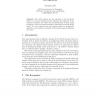Free Online Productivity Tools
i2Speak
i2Symbol
i2OCR
iTex2Img
iWeb2Print
iWeb2Shot
i2Type
iPdf2Split
iPdf2Merge
i2Bopomofo
i2Arabic
i2Style
i2Image
i2PDF
iLatex2Rtf
Sci2ools
NOLISP
2005
Springer
2005
Springer
Segment Boundaries in Low Latency Phonetic Recognition
This study analyses how the reduction of the look-ahead length of a two pass phonetic decoder influences the alignment of the segment boundaries. It is shown how the optimization of some tuning parameters, such as the insertion penalty, is dependent on the look-ahead length. It is also suggested that the insertion penalty be dynamically adjusted to some measure of similarity of the phonetic segments following each other.
| Added | 28 Jun 2010 |
| Updated | 28 Jun 2010 |
| Type | Conference |
| Year | 2005 |
| Where | NOLISP |
| Authors | Giampiero Salvi |
Comments (0)

